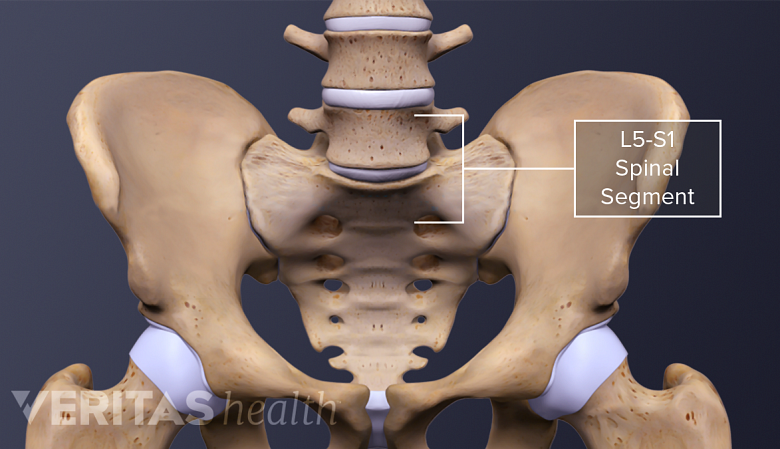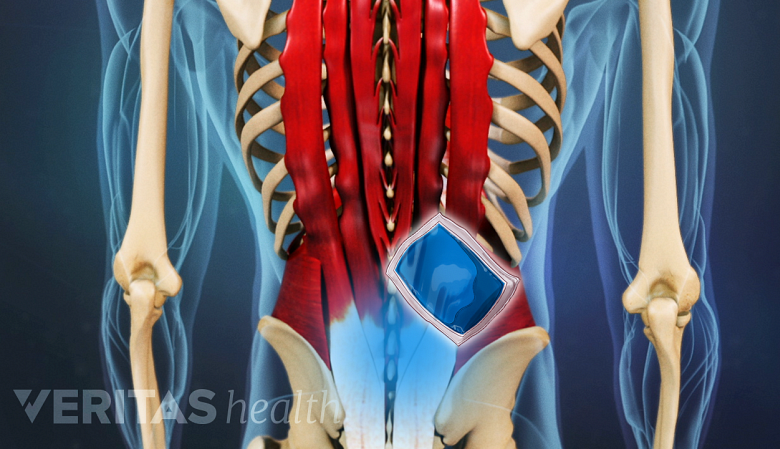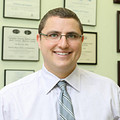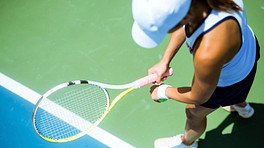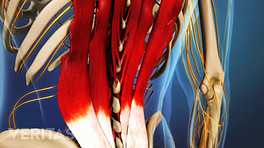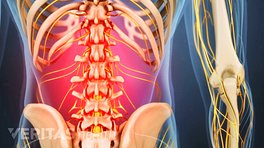It is important to note that overuse or overexertion is a major contributing factor to golf-related injuries, accounting for over 80% of reported golf injuries. 1 Gosheger G, Liem D, Ludwig K, Greshake O, Winkelmann W. Injuries and overuse syndromes in golf. Am J Sports Med. 2003;31(3):438-443. doi:10.1177/03635465030310031901 Gradually increasing the amount of time spent on the golf course will allow the muscles to slowly adapt to the demands of the sport. A little effort and caution go a long way to prevent back pain.
In This Article:
6 Ways to Proactively Protect the Lower Back When Golfing
Key steps to preventing low back pain from golf include:
1. Perform Warm-ups Before Golfing
Hamstring stretches promote flexibility and reduce muscle tightness in the low back and legs.
Going directly to the tee at 7 a.m., pulling out the driver, and proceeding to try to hit the cover off the ball is probably the surest way to sprain one's back muscles and go home with low back pain. Risk of injury decreases by about 60% when a golfer warms up or stretches for at least 10 minutes before a game. 1 Gosheger G, Liem D, Ludwig K, Greshake O, Winkelmann W. Injuries and overuse syndromes in golf. Am J Sports Med. 2003;31(3):438-443. doi:10.1177/03635465030310031901
The following 3 suggested warm-up activities help prepare the muscles before the game. 2 Gluck GS, Bendo JA, Spivak JM. The lumbar spine and low back pain in golf: a literature review of swing biomechanics and injury prevention. Spine J. 2008;8(5):778-788. doi:10.1016/j.spinee.2007.07.388
- Jumping jacks increase blood flow and warm the body.
- Stretches loosen the shoulders, torso, hips, and hamstrings.
- Gentle practice swings with a golf club prepare the muscles for the torque (force) and torsion (twisting) necessary for significant clubhead speed.
Start with the shortest clubs (wedges and short irons) and gradually transition to mid irons and woods. The driver should be the last club to swing at the practice range.
Muscles that are stretched and loaded gradually can handle large amounts of stress, making such muscles far less prone to being injured. Three examples of useful static stretches, which are stretches that hold a single position, include:
- Holding a golf club behind the neck and shoulders and then rotating the torso, to stretch the shoulders and torso
- Pulling the knee to the chest, to stretch the hips
- Bending over and trying to touch the toes, to stretch the hamstrings
Research suggests that dynamic stretches, which are stretches that involve repeated movements, are better for warm-ups than static stretches. 3 Ehlert A, Wilson PB. A Systematic Review of Golf Warm-ups: Behaviors, Injury, and Performance. J Strength Cond Res. 2019;33(12):3444-3462. doi:10.1519/JSC.0000000000003329 Three examples of helpful dynamic stretches include:
- Swinging the leg back and forth, 10 to 15 times for each leg
- Bending the knee and lifting the foot up toward the opposite hand, 15 to 20 times for each foot
- Lunging forward on one leg with arms reaching towards the sky, 15 to 20 times for each side
Afterward, it is helpful to begin swinging at the driving range, then practice at smaller irons and incrementally progress to the larger woods.
Read more about Stretching for Back Pain Relief
2. Improve the Swing to Prevent Back Pain
It is important to practice swinging before playing golf, as this part of the warm-up routine helps to prevent low back pain. Besides practicing the swing, improving the technique will also prevent injury to the back. Two common techniques include:
- The classic swing. Traditionally, the golf swing equally rotates the lower back, pelvis, and shoulder. Momentum moves in the forward direction.
- The modern swing. This popular variation limits the movement of the pelvis and increases the rotation of the torso or chest. Momentum moves in the upward direction. A high clubhead speed and a high ball trajectory are generated, but the lumbar spine may not be able to withstand the increased forces. 4 Cole MH, Grimshaw PN. The Biomechanics of the Modern Golf Swing: Implications for Lower Back Injuries. Sports Med. 2016;46(3):339-351. doi:10.1007/s40279-015-0429-1
A classic swing allows the hips to rotate during the backswing, ultimately providing the lower back some much needed relief. Although the more powerful modern swing is commonplace today, the risk to the spine is not worth the increased speed.
The following 4 aspects of the golf stance reduce risk of injury 5 Lindsay DM, Vandervoort AA. Golf-related low back pain: a review of causative factors and prevention strategies. Asian J Sports Med. 2014;5(4):e24289. doi:10.5812/asjsm.24289 :
- Keep the spine upright. Standing close to the ball will reduce the risk of bending the spine.
- Bend forward at the hips. While preparing to start the swing, bending from the hips is far safer than bending the lower back. The torso will likely tilt by about 25 degrees.
- Bend slightly at the knees. By keeping the knees bent at about 25 degrees as well, the golf club can hit the ball without causing the lower back to bend.
- Keep the feet shoulder-width apart and rotated outwards. Finally, placing the feet at outward angles of about 25 degrees assists the hips in rotating more powerfully. Weight needs to be evenly distributed on the balls of the feet.
The correct set-up ensures that minimal muscular effort is required, with minimal load on the spinal discs and facet joints. During the swing, the correct technique will distribute the load evenly across the shoulder, hip, and lower spine.
Developing an easy, fluid swing to avoid a low back injury is often easier said than done. Beginners would be well-advised to work with a golf professional, since most aspects of the swing are not natural or intuitive. A shortened swing, for example, helps to decrease the forces on the back. 6 Wadsworth LT. When golf hurts: musculoskeletal problems common to golfers. Curr Sports Med Rep. 2007;6(6):362-365. doi:10.1007/s11932-007-0052-5 Even senior golfers with decreased flexibility and strength may find golf lessons useful.
3. Limit the Forces on the Lower Back
A golf swing biomechanically stresses the L5-S1 disc space due to its unique rotational capability.
Younger golfers, between 30 and 40 years old, tend to swing the hardest while playing golf. In this age range, conditions such as degenerative disc disease or isthmic spondylolisthesis more commonly affect the lower back. It is important to understand the forces at play to achieve a fluid and safe golf swing.
Three biomechanical forces or loads are applied to the lower back during golf:
- The compressive forces. A force of over 8 times the average body weight is placed on the lower spine. This load is absorbed by the jelly-like inner material of the discs (nucleus pulposus), the core of the vertebral bone (cancellous bone), and the small joints between vertebral bones (facet joints).
- The shear forces. During a swing, the leading foot applies a force in the forward direction and the trailing foot applies a force in the reverse direction. These opposing forces are called lateral shear forces, which generate torque as the body rotates. An upright stance limits the shear force and reduces the chance of lower back pain. 1 Gosheger G, Liem D, Ludwig K, Greshake O, Winkelmann W. Injuries and overuse syndromes in golf. Am J Sports Med. 2003;31(3):438-443. doi:10.1177/03635465030310031901
- The torque. Torque refers to the force needed for twisting or turning the torso, and a higher torque is desirable for a more powerful drive. This force is felt by the shoulders, which rotate during the backswing, and the hips, which rotate upon the forward swing; torque also stresses the elbows, wrists, and lower back. 7 Brandon B, Pearce PZ. Training to prevent golf injury. Curr Sports Med Rep. 2009;8(3):142-146. doi:10.1249/JSR.0b013e3181a61c88 A portion of the torque may burden the soft tissues in the lower back, leading to minor trauma in the muscles that stabilize the spine.
The biomechanics of a golf swing largely stresses the L5-S1 disc space because the joints at this segment allow considerably greater rotation than other joints in the lower back. Flexibility in the hamstrings and hip flexors will allow more motion in the pelvis and help reduce stress to the L5-S1 disc space.
4. Safely Carry the Golf Bag
An average golf bag weighs between 25 and 30 pounds, while a professional golfer’s bag tends to weigh about 50 pounds. Traveling around the golf course with such a heavy bag is certainly a form of exercise, and some individuals may prefer to carry their own bags for the added workout.
When carrying the golf bag, it is important to:
- Lift the bag using the right bending technique
- Limit the number of times the bag is lifted
- Use dual bag straps to evenly divide the weight across the back
An integrated golf bag stand, which opens when the bag is set on the ground, eliminates the need to repeatedly bend over. Whenever possible, simply avoid lifting or carrying the golf bag.
5. Cool Down After the Game
Cold packs reduce back pain by decreasing inflammation and numbing the area.
As with any exercise, the cool-down routine is essential to gradually bring heart rate and blood pressure to resting levels while relaxing the muscles. Even 5 minutes of static stretching can adequately protect the muscles from cramping.
Recommended cool-down activities include:
- Ice application
- A light jog or brisk walk
- Yoga poses, such as Downward Dog or Child’s Pose
- Easy stretches for the core, pelvis, arms/shoulders, and hamstrings
In some golf clubs, massage services are available to help ease tension, relieve pain, or prevent muscle soreness.
6. Rest Well Before the Next Day of Golf
Excessive golfing repetitively uses the muscles at high amounts of force, leading to back pain as well as other common golf-related pains, such as in the shoulder or wrist. Rest is required in between the days on the golf course to prevent overuse of these important muscles. Consider alternating between playing 9 holes and 18 holes per round when playing on consecutive days.
When practicing golf to become professional, up to 6 days a week are generally recommended to improve scores, with each day lasting between 4 to 6 hours. However, with low back pain, it is best to limit golf days to no more than 2 to 3 times a week and to stop playing when back pain strikes.
- 1 Gosheger G, Liem D, Ludwig K, Greshake O, Winkelmann W. Injuries and overuse syndromes in golf. Am J Sports Med. 2003;31(3):438-443. doi:10.1177/03635465030310031901
- 2 Gluck GS, Bendo JA, Spivak JM. The lumbar spine and low back pain in golf: a literature review of swing biomechanics and injury prevention. Spine J. 2008;8(5):778-788. doi:10.1016/j.spinee.2007.07.388
- 3 Ehlert A, Wilson PB. A Systematic Review of Golf Warm-ups: Behaviors, Injury, and Performance. J Strength Cond Res. 2019;33(12):3444-3462. doi:10.1519/JSC.0000000000003329
- 4 Cole MH, Grimshaw PN. The Biomechanics of the Modern Golf Swing: Implications for Lower Back Injuries. Sports Med. 2016;46(3):339-351. doi:10.1007/s40279-015-0429-1
- 5 Lindsay DM, Vandervoort AA. Golf-related low back pain: a review of causative factors and prevention strategies. Asian J Sports Med. 2014;5(4):e24289. doi:10.5812/asjsm.24289
- 6 Wadsworth LT. When golf hurts: musculoskeletal problems common to golfers. Curr Sports Med Rep. 2007;6(6):362-365. doi:10.1007/s11932-007-0052-5
- 7 Brandon B, Pearce PZ. Training to prevent golf injury. Curr Sports Med Rep. 2009;8(3):142-146. doi:10.1249/JSR.0b013e3181a61c88
